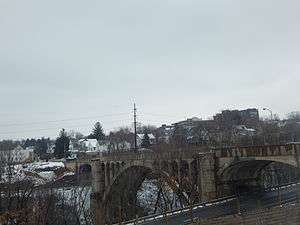Harrison Avenue Bridge
| Harrison Avenue Bridge | |
|---|---|
|
The Harrison Avenue Bridge in March 2015, with the Central Scranton Expressway under the right-most arch. | |
| Carries | Harrison Avenue (State Route 6011) |
| Crosses | Roaring Brook and Central Scranton Expressway |
| Locale | Scranton, Pennsylvania |
| Other name(s) | South-East Scranton Viaduct |
| Maintained by | PennDOT |
| Characteristics | |
| Design | Open-spandrel deck arch |
| Material | Concrete |
| Total length | 407 feet (124 m) |
| Width | 40 feet (12 m) |
| Longest span | 202 feet (62 m) |
| Number of spans | 3 |
| History | |
| Designer | Abraham Burton Cohen |
| Constructed by | Anthracite Bridge Company |
|
Harrison Avenue Bridge | |
|
The Harrison Avenue Bridge in 1999. | |
 Location in Pennsylvania | |
| Coordinates | 41°24′00″N 75°39′05″W / 41.400000°N 75.651388°WCoordinates: 41°24′00″N 75°39′05″W / 41.400000°N 75.651388°W |
| Area | less than one acre |
| Built | 1922 |
| MPS | Highway Bridges Owned by the Commonwealth of Pennsylvania, Department of Transportation TR |
| NRHP Reference # | 88000767[1] |
| Added to NRHP | June 22, 1988 |
Harrison Avenue Bridge is a concrete deck arch bridge carrying Harrison Avenue (unsigned SR 6011) in Scranton, Pennsylvania, United States. Its three spans include an open-spandrel ribbed arch over Roaring Brook, flanked by two closed-spandrel arches. The southwestern closed-spandrel arch spans the former Lackawanna and Wyoming Valley Railroad (Laurel Line), converted to highway use in 1964 as the Central Scranton Expressway.[2] The northeastern closed-spandrel arch spans the former Delaware, Lackawanna and Western Railroad, now a heritage railroad operated by Steamtown National Historic Site.
Built in 1921-1922, the bridge is notable as an example of Progressive Era civic involvement, its construction having been promoted by a citizens' group called the South to East Scranton Bridge Association. It was designed by New York City-based consulting engineer Abraham Burton Cohen, although Scranton Department of Public Works chief engineer William A. Schunk and his assistant Charles F. Schroeder were more actively involved in day-to-day supervision of construction.[3] The bridge was listed on the National Register of Historic Places in 1988.
See also
- List of bridges documented by the Historic American Engineering Record in Pennsylvania
- List of bridges on the National Register of Historic Places in Pennsylvania
- National Register of Historic Places listings in Lackawanna County, Pennsylvania
References
- ↑ National Park Service (2010-07-09). "National Register Information System". National Register of Historic Places. National Park Service.
- ↑ Henwood, James N. J.; Muncie, John G. (1986). Laurel Line: An Anthracite Region Railway. Glendale, CA: Interurban Press; reprint, Eynon, PA: Tribute Books, 2005. p. 186. ISBN 0976507234.
- ↑ Spivey, Justin M. (August 1998). "Harrison Avenue Bridge" (PDF). Historic American Engineering Record. Washington, D.C.: Library of Congress. pp. 10–11. Retrieved February 1, 2014.
External links
- Historic American Engineering Record (HAER) No. PA-498, "Harrison Avenue Bridge", 7 photos, 17 data pages, 1 photo caption page
- Anthracite Bridge Company information at Structurae
- Abraham Burton Cohen information at Structurae
- Harrison Avenue Bridge at Structurae

